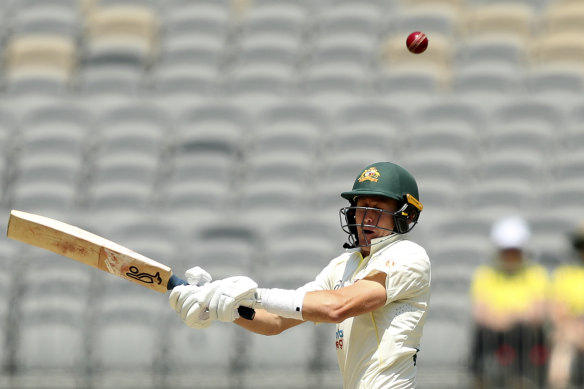
A major cut in international match ticket prices outside school holidays to bring them closer to Big Bash levels is a lever Cricket Australia may consider pulling as a way of helping to bring crowds back after COVID-19.
Numerous past and present decision-makers spoken to by The Age and The Sydney Morning Herald on Monday agreed that pricing and incentives for spectators needed to be looked at for future summers, irrespective of crowds for the remainder of the season.
While the Adelaide Test’s enduring appeal as a destination event is expected to attract around 20,000 spectators to each of the first three days of the second Test against the West Indies from Thursday, Perth’s slim attendance following a trio of similarly paltry crowds for an ODI series against England has caused administrators to dust off past research on ticket sales.

Marnus Labuschagne’s double century and century in the same Test was made in front of slim crowds.Credit:AP
There are plenty of these in the bottom drawers of CA executives and board directors, including a study conducted personally by current chief executive Nick Hockley that led to the introduction of extra categories and a lower, $30 entry point for seats.
One suggestion discussed internally the CA board table in recent years was a radical proposition of making Test match public entry free after day one, on the basis that the extra spectators attracted by the offer would then spend more money on food and drinks, while also making the game look more attractive for broadcasters.
Another piece of research, conducted by the marketing firm Forethought in 2013, found that the single biggest factor in cricket attendance was cost, and that among other factors including transport, food and beverage prices, the cost of the tickets themselves was the stand-out determining factor.
Australian summer Test match attendances
Year Opposition Days Total Ave
2022-23 WI 5 42,723 8544
2021-22 Eng 20 488,004 24,400*
2020-21 Ind 17 228,003 13,412*
2019-20 Pak/NZ 20 520,950 26,048
2018-19 Ind/SL 26 564,886 21,726
* COVID crowd restrictions
Those findings contributed to advertising campaigns for the BBL that stressed the cheap cost of a family ticket - just $42 - to the exclusion of almost everything else. That simple message was at the centre of BBL advertising for six years, before the tournament began to creak under the weight of a rapid increase to 14 games per team.
Many a debate has taken place within CA about the appropriate balance between accessible ticket prices and the money to be gleaned from sales, especially against the backdrop of broadcasters wanting full stadiums for the matches they air.









 Add Category
Add Category